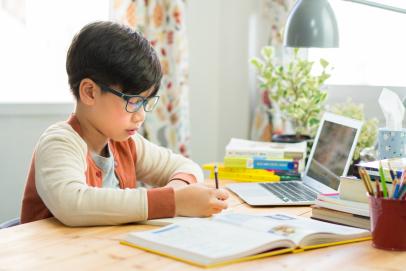 By: Kendall Hunt RPD with contributions from the editorial team of Pathways2.0
By: Kendall Hunt RPD with contributions from the editorial team of Pathways2.0
The end of the 2020 school year was a bumpy road as COVID-19 forced us to transition abruptly to at-home education. No one, from students to teachers to parents, emerged from the changes unscathed.
Except, that is, for those students and parents who were at home already.
According to data from the National Center for Education Statistics (NCES), in 2019, just over 1.6 million American children, or about 3%, were homeschooled. And their educators—usually parents or other family members, although some homeschool co-ops employ licensed teachers—can teach us a thing or two about home education.
Hopefully, this fall will see students and teachers back in the classroom, albeit with additional safety precautions. But even if we are able to return to in-person education, it never hurts to be prepared.
In the hope that you never need them, but realizing that we likely haven’t seen the end of the educational changes we saw this spring, we offer homeschool parents’ top-five tips to help new homeschoolers (either voluntary or forced) make the most of home education.
1. Emphasize quality over quantity, and understand that your students probably will miss content
“Will there be gaps? Yes, just as there would be in school, because learning is a life-long adventure,” said Lisa Rivero, a homeschooler for over 10 years, in a 2010 seminar with the Davidson Gifted Institute. Although her words are directed at full-time homeschoolers, they ring true for those pinch-hitting during circumstances like COVID-19. It’s important that students get the content they need to prepare them for their next educational steps, but they’re most likely not going to get to everything ... and that’s okay because guess what? No traditional classroom gets to “everything” either!
“I wanted to ensure that each of the boxes got checked on the kids’ schoolwork, [and] the pressure to perform to some imagined level concerned me on a daily basis,” wrote Bonni Stachowiak in an EdSurge column discussing her experience with homeschooling during COVID-19. But, she said, “The kids’ teachers did a good job of telling us what assignments or activities were most important, from their perspective … I grew to understand that if we didn’t get to everything, it wasn’t going to cause irreparable harm to the kids’ learning.”
2. Know that it’s not going to look like “normal school”—and that’s okay
Don’t sweat it if you can’t get your students to follow the same schedule they did at school.
"Because this is such a unique situation, it’s OK to let everyone sleep in a bit later," said Jen Reyneri, who has homeschooled two sons (ages 16 and 12), in an interview with CNN.
In an interview with Houston Public Media, homeschool moms Ashley Fuori, Blair Bailey, and Lara Clinton urged parents “to try not to re-create school at home”; instead, “let kids choose when and where they want to work.”
Of course, your child’s school may ask them to log on at certain times or be present for certain online meetings. But when they’re given freedom to learn at their own pace, make the most of it, and don’t worry that you’re not replicating the school environment. You’re not—and that’s just fine. Given the resources, students will learn, even if the location and method are different.
3. But do make a schedule
There’s a big difference between encouraging self-directed learning and removing all semblance of structure. The article from CNN notes that “most kids work off a schedule in their classrooms, so re-creating something similar at home can ease the transition to a different learning environment for the foreseeable future.”
Whether it’s making a to-do list of assignments for the day or setting specific times to tackle each subject, making a schedule is key. Just make sure to let your students help you make that schedule (within reason). In that way, you’re giving them the freedom that Fuori, Bailey, and Clinton discussed but also making sure that no one loses his or her sanity.
4. As much as you can, set kids up for independent learning
For working parents, the transition to suddenly becoming full-time homework helpers as well as full-time employees was incredibly daunting. Stachowiak and her husband were in that very situation, and she said independent work has been their saving grace: “We try to set up a schedule for the kids so that they can move through a few school tasks at a time without us needing to guide them,” she wrote. “We do our best to schedule related tasks together in the hopes that they can move from one activity to the next without us always needing to stop what we are working on to guide them.” (Lest you think your children aren’t old enough to handle independent work, the Stachowiaks’ kids are six and eight!)
5. The Internet is your friend
“Remember, you have everything you need at your fingertips, literally,” said Cynthia Polakovic, a six-year homeschool veteran, in an article for South Shore Health in Massachusetts. “The Internet offers a vast network of support for every academic subject imaginable.”
Your child’s teachers likely have offered—and will continue to offer—online resources for parents and students. Make the most of them, but also don’t be afraid of a simple Google search (being sure to use reliable sources, of course). There’s absolutely no shame in not being able to answer a child’s question or not understanding the directions on their homework assignment. When (not if) that happens, use your resources effectively.
What resources, tips, or strategies helped you make it through COVID-19 education?
Resources:
https://www.davidsongifted.org/search-database/entry/a10681
https://www.southshorehealth.org/wellness/blog/homeschooling-tips-parents-during-covid-19
https://nces.ed.gov/programs/digest/d18/tables/dt18_206.10.asp
https://www.cnn.com/2020/03/16/health/homeschooling-during-coronavirus-wellness/index.html